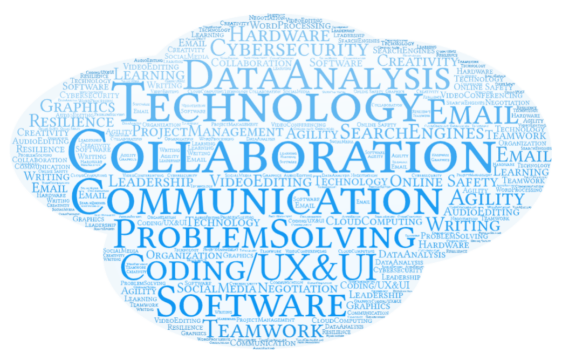Gen Z and Gen Alpha will enter a workforce that looks very different than the one their parents and grandparents experienced. Educators know it’s important to consider what skills their students will need to succeed now and in the future, but with the rapid rate that new technologies emerge, it can be very difficult to decide which skills to focus on. After all, who knows which skills will be relevant for students in the years and decades to come?
Having worked in corporate environments and in classrooms as a technology teacher myself, here’s the advice I’ve been giving educators lately, about how to prepare their students for the workplace of the future.
Start in the classroom
To overcome that initial sense of overwhelm, I suggest that educators start by thinking about the skills they wish their students had right now. Hands down, the first skill they mention is keyboarding fluency. That’s a foundational skill that will help students with almost everything else in school such as accessing their learning management system, composing responses to prompts, sending emails, and even learning to code. Guess what? It’s not any different outside the classroom. Keyboarding is an essential skill used across millions of jobs, and used in navigating our daily lives, too.
During planning meetings, I ask educators what additional skills would be useful to students in your classroom, once they’ve mastered keyboarding. The response constantly leans towards the ability to use productivity apps such as word processing, presentation, and spreadsheet software. Some educators even suggest multimedia, “It would be great if students could make a movie about what they learned!” My goal is to establish links between the skills educators desire for their students to the skills sought by employers. That’s when the lightbulbs illuminate with the realization: maybe it’s not that tricky to figure out what technology skills we should be focusing on teaching our students. The skills they need to succeed right now in the classroom are going to serve them well outside the classroom, too.
Skills for a tech-driven world
But educators also realize that the technology itself is just one piece of the puzzle. To compete in a world that is so technology-driven requires higher order thinking and digital literacy skills such as computational thinking and data analysis.
For example, accountants don’t only need to know how to use a spreadsheet, they also need to be able to analyze, synthesize, and communicate their key findings. To succeed in the future workplace, students will need the critical thinking and problem solving skills that are already central to most classrooms.
One of my favorite exercises with students is to have them type into the computer “careers that use ____” and insert skills they’re working on, or things they enjoy. This can be rewarding and eye opening! It can also help course correct if, for example, a student is surprised to learn that playing video games does not itself prepare them to become a video game designer. If they have a career in mind, they may need to research and level up their skills, starting in school.
Success requires soft skills
The news is flooded with articles about the skills needed in today’s workplace, like these:
- “12 Essential Technology Skills (And How To Improve Them)” (Indeed)
- “The Nine Most Important Soft Skills in the Workplace” (Mondo)
- “The 12 Most Important Skills You Need to Succeed at Work” (Forbes)
- “The 10 Most In-demand Skills Employers Want to See on Your Resume Right Now” (CNBC)
I looked at a dozen similar articles, and, as you can see below, soft skills such as collaboration, communication, and problem solving are mentioned just as frequently as technology skills for being essential to workplace success.

So how do you teach your students soft skills like collaboration and resilience? A lot of soft skills can be acquired organically through technology projects. For example, in the age of artificial intelligence, we can teach students about integrity by talking about how to ethically use AI such as ChatGPT, and to ask them to think about “how do you use this tool when no one else is watching?” Educators and students alike are often surprised to learn AI can function as a tutor, assist in managing projects and team role assignments, and serve as a coach they can turn to for collaboration challenges. Helping students understand what AI can do for them now can help them imagine how it might be used in the future.
You can help students practice effective communication by having them work on a group project. Many years ago, before the age of remote learning, I had an 8th grade tech class pretend they were working remotely. We spent a week on a collaborative project only communicating through our LMS email system. Students rapidly grasped the necessity for advanced communication and planning to ensure timely email responses to keep projects moving forward, which led to conversations about teamwork and adaptability. During the midpoint of the project, students exchanged their roles. Consequently, the former role holder assumed the responsibility of guiding and mentoring the student who transitioned into their previous role. Observing students coaching each other built a strong foundation for workplace skills such as onboarding, cross-team functionality and internal customer service. Throughout any group project, students can both leverage technology and strengthen the soft skills that will be necessary for workplace success.
Changing workplaces
It’s not just Gen Z that’s preparing for the workforce. They’re actively reshaping it. Forbes recently reported that Gen Z has surpassed Baby Boomers as the generation having the greatest impact on the workplaces – from their preference for remote work to chats and instant messaging instead of emails.
“Perhaps the most significant but ignored change for businesses will be adapting to young workers’ expectations for accommodations for their learning or communication styles, neurodiversity, and both mental and physical health needs.”
–Diane Gayeski, professor of strategic communication, Ithaca College
One of the ways Gen Z is changing the workplace is through their desire for instant gratification. While this impacts employers, it also has an effect on learning. Young people today may not want to sit through a lengthy, multi-part course to gain skills, but we can help them get used to finding video tutorials or joining online groups to improve their own skillsets now and in the future.
Final thoughts
Our students are going into workplaces that increasingly rely on technology. In fact, STEM jobs are expected to grow faster and pay better than non-STEM jobs over the next few years. As educators, the technology and soft skills you are introducing to students – whether they are in 3rd grade or 11th – are going to be skills that they continue to use and build on throughout their education, and in the workplace.

Nicasia Anzalone Caires, M.Ed.
State Program Manager
Nicasia Anzalone Caires, M.Ed., is a state program manager for Learning.com, with over 20 years of experience in e-learning and curriculum development. As former online teacher, student, and trainer, she offers a unique understanding and growing appreciation for customized learning from both the designer and end user perspectives.

